Livestock production faces multiple health challenges, one of the most critical being intestinal dysbiosis in production animals. This imbalance in the microbial ecosystem of the digestive tract not only impacts production efficiency but also has implications for human and environmental health, aligning with the One Health approach promoted by the WHO and FAO.
What is Dysbiosis and How Does It Affect Livestock Production?
Dysbiosis refers to an imbalance in the intestinal microbiota, characterized by an increase in pathogenic microorganisms and a reduction in beneficial bacteria. In intensive production systems, factors such as indiscriminate antibiotic use, stress, poor diets, and inadequate sanitary conditions can trigger this imbalance.
Effects of dysbiosis include:
- Lower feed conversion efficiency.
- Increased susceptibility to bacterial infections such as Salmonella spp., Escherichia coli, and Clostridium perfringens.
- Intestinal inflammation and digestive disorders.
- Negative impact on animal welfare and higher veterinary costs.
Dysbiosis in Broiler Chickens: Scientific Evidence
The high genetic potential and large feed intake capacity of broiler chickens make them particularly vulnerable to intestinal dysbiosis. A recent study evaluated the impact of Fortcell Feed Aviculture (FF), a microencapsulated multi-strain probiotic, on gut health and pathogen control in commercial farms.
Study Results
- FF eliminated Salmonella enterica and significantly reduced levels of Staphylococcus spp., Pseudomonas spp., Klebsiella spp., and E. coli.
- Improved feed conversion ratio (FCR), decreasing from 1.69 in the control group to 1.59 in the treated group.
- Reduced mortality by 48%.
- Contributed to more efficient and sustainable poultry production, aligning with global trends to reduce antibiotic use.
Learn more about this study by listening to our podcast here (click to listen).
Dysbiosis and Its Impact on Human and Environmental Health
The One Health approach recognizes the interconnectedness of animal, human, and environmental health. Intestinal dysbiosis in production animals has broader effects beyond livestock performance:
🔬 Antimicrobial Resistance (AMR): Excessive antibiotic use to treat intestinal diseases promotes resistance in pathogenic bacteria, which can be transmitted to humans through meat products and the environment. Recent WHO studies (2023) warn that AMR will be one of the greatest global health threats in the coming decades.
🌍 Environmental Impact: Alterations in the gut microbiome of animals can lead to higher excretion of pathogens and nitrogenous waste, contributing to soil and water contamination. FAO research (2022) highlights how livestock systems influence the microbial biodiversity of ecosystems.
👩⚕️ Human Health: The transmission of resistant pathogens from livestock to humans is a growing concern. Cases of multidrug-resistant E. coli infections in humans have been linked to intensive pig and poultry production, according to studies by Van Boeckel et al. (2020).
Biotechnological Strategies to Prevent Dysbiosis
To address this challenge, biotechnology applied to animal nutrition has developed innovative solutions, such as microencapsulated probiotics that help restore gut microbiota without the need for antibiotics.
The Fortcell Feed Aviculture study demonstrates that it is possible to mitigate intestinal dysbiosis through specific probiotics, reducing the presence of enteropathogens and improving animal digestive health.
At Bialtec, we develop advanced formulations that promote intestinal health in animals, enhancing the sustainability of livestock production while reducing antibiotic dependence. The future of livestock production must be efficient, responsible, and sustainable.
The key is in science and innovation.






